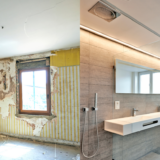If you’re looking at installing new flooring in your home and are on a budget, you may be tempted to try to do it yourself. Doing your own install can save you money, but it can also cost you in other ways. Your time is valuable and if you spend that time trying to save a few bucks on installation, how much would that time be worth? That’s where having an understanding of the fair market costs for professional services comes in handy. Not only will knowing what professionals charge let you know when DIY is more affordable than hiring pros; it will prevent you from getting taken advantage of by untrustworthy contractors. Below are some helpful tips on how to know when the price for installing new flooring is worth it.
Know your flooring type before getting a quote
The first thing you need to know about installing any type of flooring is what you’re installing. There are many different types of flooring and each type has its own installation requirements. This will determine the price you’ll pay to have it installed. If you don’t know what type of flooring you want to install in your home, you won’t be able to compare prices until you do. If you’re not sure which flooring will be best for your needs, take a look at some of the options below. – Hardwood flooring – The most basic type of flooring is hardwood flooring. This type of flooring comes in a variety of species and finishes, so you can choose exactly what you want for your home. While it’s a sturdy and durable option, hardwood also requires a more complex installation process than other types of flooring. – Laminate flooring – This type of flooring is a great choice for households with kids or pets. It’s easy to clean and resistant to scratches and stains. Laminate flooring is a bit more affordable than some other types of flooring, but it does come with a lower price tag for a reason. Laminate has a more plastic-like aesthetic compared to real hardwood flooring. It’s also less durable than real hardwood, so it’s not a good choice for households with a lot of foot traffic. It may also be difficult to match laminate flooring to other flooring or décor in your home. – Rugs and area rugs – While a rug is not a flooring type, it’s sometimes used to cover up a less-than-ideal flooring underneath. Rugs and area rugs are great for adding pattern or color to a room without making any long-term changes to your home’s interior design. If you have a rug that you love but need to protect your kids or pets from stains, you can also put down an area rug on top of it.
Determine how much time you’re willing to invest
If you’re thinking about DIYing your flooring installation, you’ll want to think about how much time you’ll spend on the project. Some types of flooring can be installed relatively quickly, while others can take a long time to install. As you compare prices between DIY and hiring a contractor, you can also consider what your hourly wage would be if you spent that time working at a part-time job. If you make $15 per hour at your 9-to-5, and you spend 8 hours installing your new flooring, you’ve just made $120 in that time. If you instead spend that $120 on hiring a contractor, you’re getting a service you may need again in the future.
Ask about warranties and know your warranty rights
If you’re installing new hardwood flooring, laminate flooring, or tiles, you may be able to find a contractor that offers a warranty. This means if there are any issues with the installation, you may be able to get it repaired or replaced at no cost to you. This can be a great benefit, but be sure to read the fine print to make sure you know what is and isn’t covered in the warranty. If you’re installing a type of flooring that doesn’t usually come with a warranty, there are some steps you can take to protect your investment. One thing you can do is lay down a layer of vinyl or rubber flooring under your new flooring to prevent it from getting damaged. You can also install vinyl tiles over your subfloor to protect it from damage while you’re waiting for the new flooring to be installed.
Be wary of up-front fees
Some contractors will charge an upfront installation fee, which is paid out of pocket before the work begins. Most reputable contractors will only charge this fee if you opt for special installation features like underlay or heat-activated glue application. Be wary of contractors who want to charge you an upfront fee with no explanation as to why. While contractors should charge you for the cost of materials, like glue or underlay, they shouldn’t charge you for their time. A contractor’s time is valuable, and if you hire them to install your flooring, you should only pay for their time at the end of the project when you’re happy with the work that was done.
Conclusion
Flooring is a major home improvement project that will have a major impact on your home’s interior design and functionality. While it can be tempting to save money and DIY your flooring installation, it’s important to know what contractors charge and what they offer in return. While DIYing your flooring installation won’t always be more affordable than hiring a contractor, it will always be more affordable than hiring a contractor and doing the work yourself. If you want a Free Estimate go to www.rewyndprojects.ca and book yours today!







0 Comments